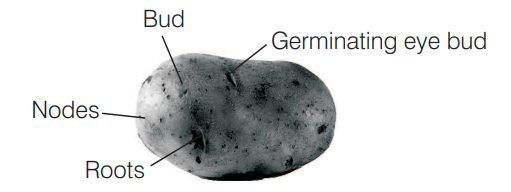Although potato tuber is an underground part, it is considered as a stem. Give two reasons.
Potato tuber is considered as a stem because of the following reasons
 (i) The tuber has nodes and internodes.
(i) The tuber has nodes and internodes.
(ii) Leafy shoots appear from the nodes.
Between an annual and a perennial plant, which one has a shorter juvenile phase? Give one reason.
In a lifespan, the organism has to grow and develop (the juvenile phase). After that the organism mature sexually and enter into the reproductive phase, before it undergoes senescence followed by death.
Since, the entire life cycle of an annual plant is shorter and has to be completed in one growing season, its juvenile phase is shorter than that of a perennial plant.
Rearrange the following events of sexual reproduction in the sequence in which they occur in a flowering plant embryogenesis, fertilisation, gametogenesis, pollination.
The correct sequence of events of sexual reproduction in a flowering plant are as follows gametogenesis, pollination, fertilisation, embryogenesis.
The probability of fruit set in a self-pollinated bisexual flower of a plant is far greater than a dioecious plant. Explain.
The probability of fruit set in a self-pollinated bisexual flower of a plant is far greater than a dioecious plant.
In self-pollinated bisexual plants transfer of pollen to stigma of flowers is easier than the dioecious plants. It is so because the anther and stigma lie close to each other and pollination is not effected even in the absence of pollinator. But in dioecious plants pollinator is necessary to bring about effective pollination as the anther and stigma lie away from each other.
Is the presence of large number of chromosomes in an organism a hindrance to sexual reproduction? Justify your answer by giving suitable reasons.
No, presence of large number of chromosomes in an organism is not a hindrance to sexual reproduction. Ophioglossum (a fern) has chromosome number 1260, still it can reproduce sexually.
In higher organisms, the chromosomes are present in a compartment called nucleus, within the cell. Whether the number is small or large, the chromosomes are duplicated and then segregated inside this compartment, during cell division. The basis of sexual reproduction is generation of haploid gametes.